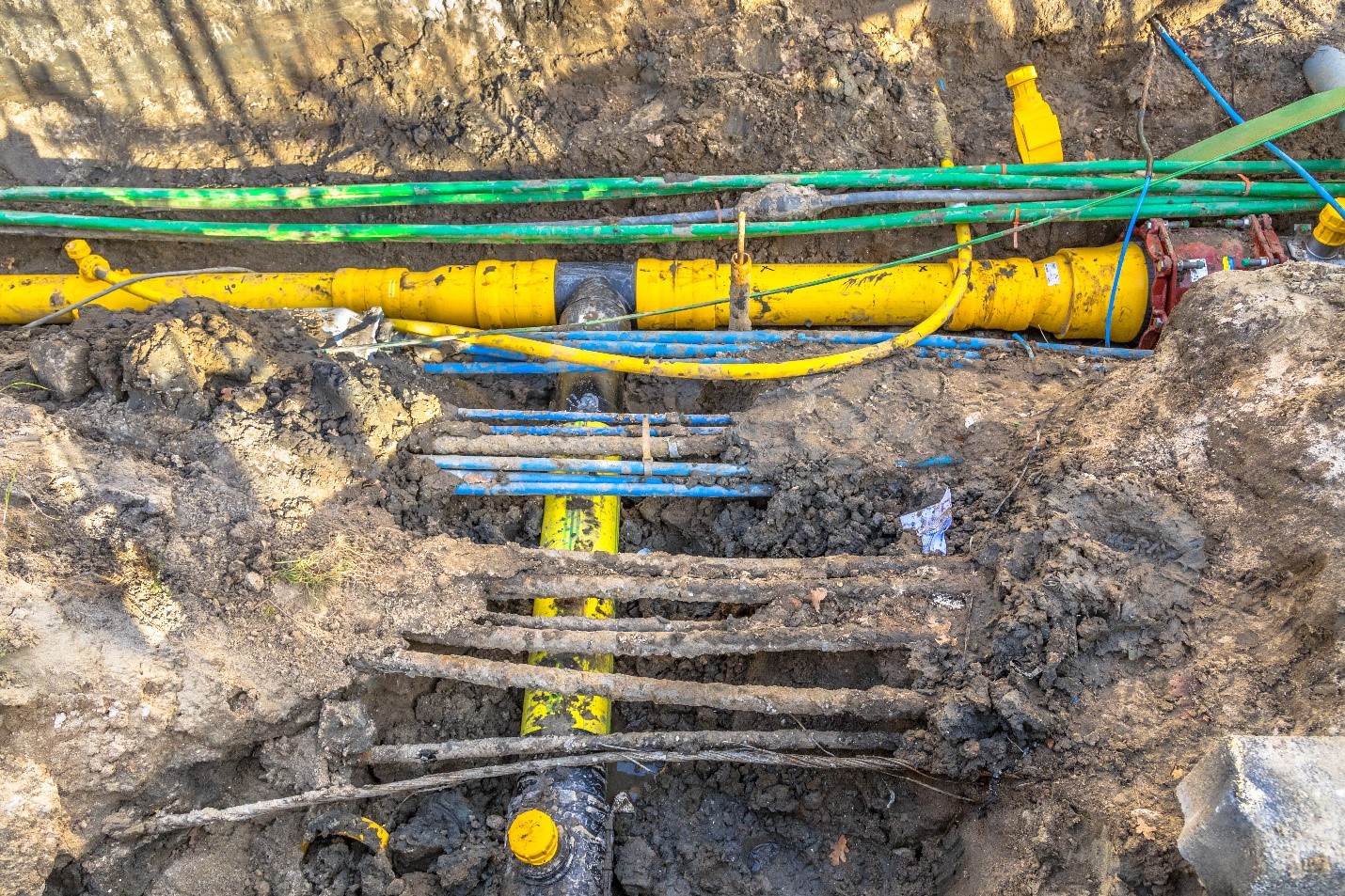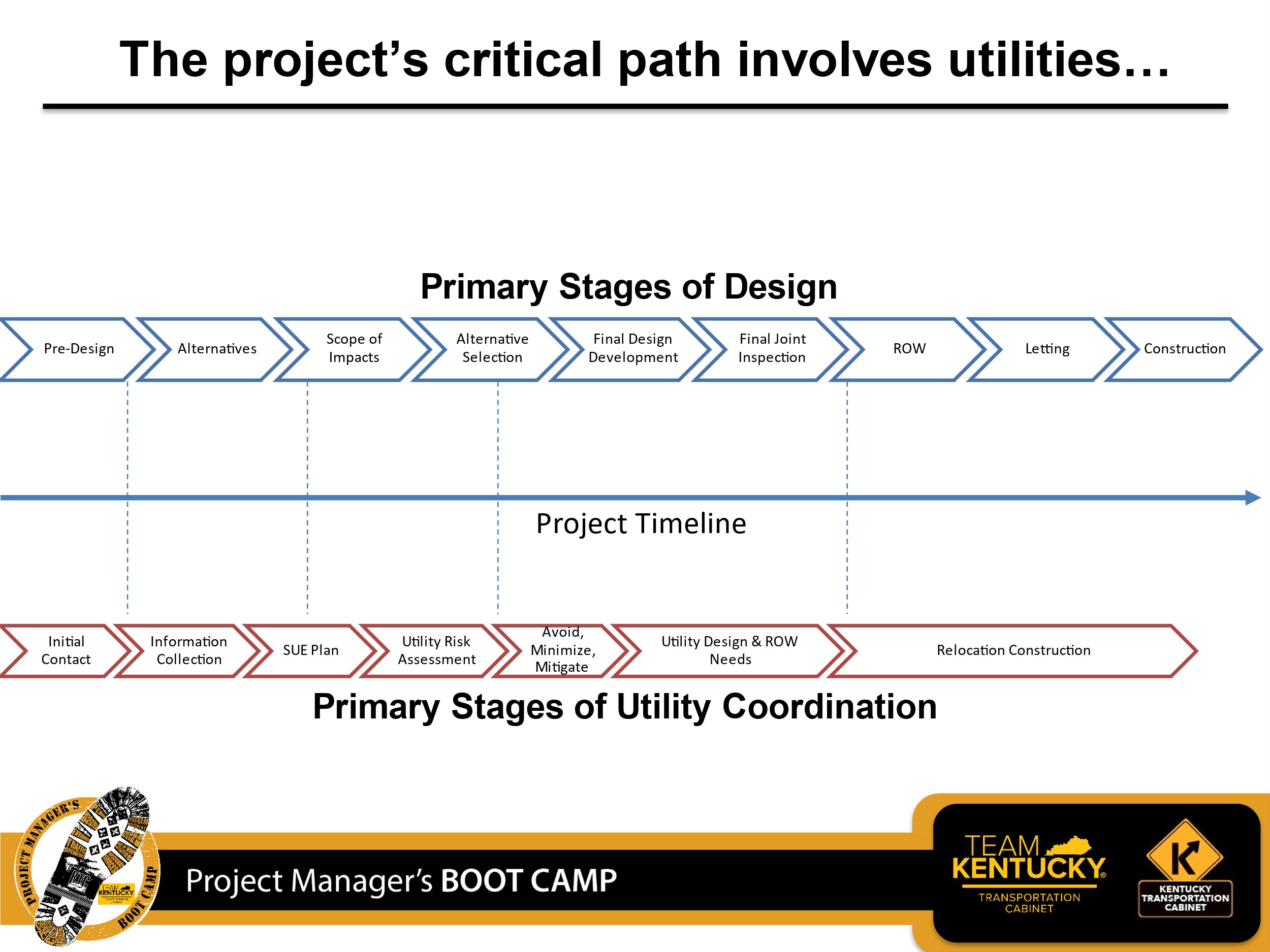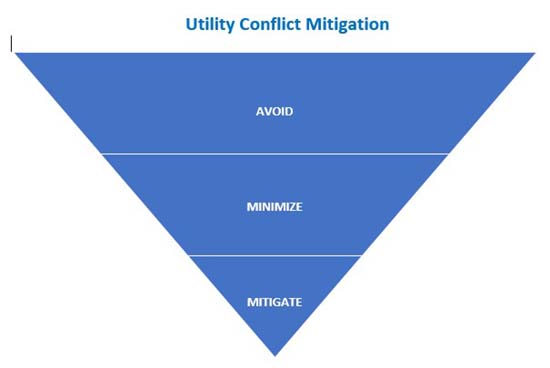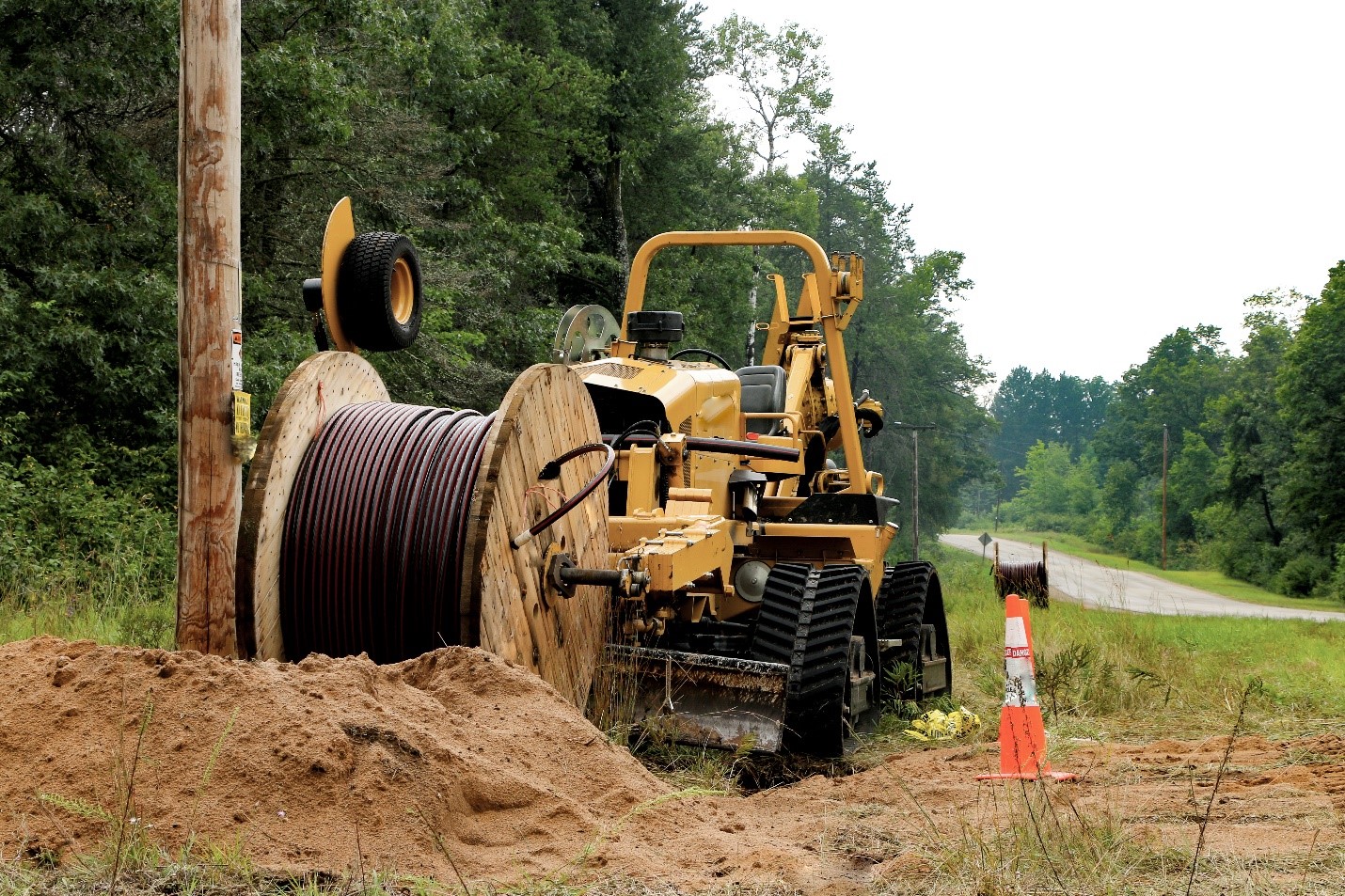Search for articles or browse our knowledge portal by topic.
Project Management and Utility Coordination

Contents
2. Utility Coordination in Preliminary Design
3. Utility Coordination in Final Design
4. Utility Phase Funding and Estimates
5. Utility Agreements and Authorizations
6. Joint Utility Information Meeting
7. Utility Relocation Plans and Cost Estimate
8. Utility Permits within KYTC ROW
| Project Management and Utility Coordination | Project Classification | |||
| Capital Improvement Projects | Safety Projects | Asset Management Projects | Maintenance Projects | |
| 1.0 Introduction | x | x | x | x |
| 2.0 Utility Coordination in Preliminary Design | x | x | x | x |
| 3.0 Utility Coordination in Final Design | x | x | x | x |
| 4.0 Utility Phase Funding and Estimates | x | x | x | x |
| 5.0 Utility Agreements and Authorizations | x | x | x | x |
| 6.0 Joint Utility Information Meeting | x | x | ||
| 7.0 Utility Relocation Plans and Cost Estimates | x | x | x | x |
| 8.0 Utility Permits within KYTC ROW | x | x | x | x |
| 9.0 Right of Way for Utilities (When Applicable) | x | x | x | |
| 10.0 Utility Relocation Work | x | x | x | x |
Terms
The full definition for terms included in this article (listed below) can be found in the HKP Glossary.
- Subsurface Utility Engineering (SUE)
- Compensable Utility
- Utility Impact Notes
A utility is a privately or publicly owned facility, or system that produces, transmits, or distributes commodities that directly or indirectly serve the public. Utility facilities, unlike most other fixed objects that may be located within the highway right of way (ROW) are not owned by KYTC. Nor are their operations directly controlled by state or local transportation agencies. As a consequence, agencies have developed policies and practices that govern when and how utility companies may use public highway ROW and the conditions under which public funds may be used to relocate utility facilities, prior to, or as part of road construction. For further information see UR-203.
Highway projects often impact utility facilities. Given the amount of time needed to relocate affected facilities or redesign plans to avoid impacting facilities, utility coordination must begin early in project development. The Utilities and Rail Branch administers KYTC’s utility relocation function and supports District Utility Supervisors (DUS) and their staff statewide. Project Managers (PMs) need to coordinate with a DUS and provide them information on the project corridor. With this information in hand, the DUS can contact utility companies to determine if they have facilities on the corridor.
Utility companies that need to relocate facilities must provide KYTC with relocation plans developed either in-house or by an approved consulting firm. Companies have two options — relocate facilities themselves and/or their contractor, or include their relocation plans in KYTC’s construction plans so the roadway contractor can relocate facilities. For a full explanation of this process, refer to the Utility & Rails Guidance Manual.
During project development the DUS, working with the PM and design staff, should:
- Identify, verify, and locate the known facilities within the project limits.
- Provide up-to-date roadway plans to the impacted utility companies.
- Identify and verify utility conflicts.
- Determine, if possible, whether the project design can avoid any of the conflicts.
- Estimate of the cost and time frame to relocate facilities.
- Work with impacted utility companies to facilitate timely solutions and the development of utility relocation plans. Preferably, these plans should be included in the Final Project Plans so the roadway contractor can relocate these facilities in coordination with their construction phasing.

Image Source: 2023 PMBC- Utilities Presentation-McCleve
Side Note
To avoid delays in developing utility relocation plans, a PM must provide the DUS with the most up-to-date plans (DGN files) that capture any changes that could affect relocations. The DUS forwards these plans to utility companies for use by their design staff.
PMs must begin coordinating with the DUS early in project development. Once the project scope is developed, the PM should discuss the project corridor with the DUS and have them reach out to local utility companies to see if they have existing or proposed facilities within the corridor. If utility companies have facilities in the project area, often they can provide KYTC with facility maps that show basic utility type and location information. If available, the DUS should provide utility as-built information to the PM.
During an initial project survey, KYTC must attempt to locate every aboveground and any indicators of underground facilities along the project corridor. The quality level of utility facility location work refers to the degree of accuracy achieved when mapping the horizontal and vertical position of facilities. Table 1 summarizes the attributes of each quality level. Quality level should be chosen based on the potential for conflict and stage of project development.
| Table 1 Description of Utility Surveying Quality Levels | ||
|---|---|---|
| Quality Level | Application | Description of Work |
| QL D |
|
|
| QL C |
|
|
| QL B |
|
|
| QL A |
|
|
If KYTC uses a consultant, the PM must specify in the advertisement for consultant services the required quality level of location work at different stages of project development. HD-304 contains more detailed information on utility locations practices.
Prior to the Preliminary Line and Grade Inspection (PL&G), the PM submits plans to the DUS for evaluation. The DUS prepares preliminary cost estimates for alignments that will be evaluated at the PL&G based on their potential impacts to utility facilities. The DUS should also discuss the estimated time frame for any relocations to be completed. These estimates along with other cost and schedule estimates are used to determine the preferred alignment to carry into the final design.
Side Note
When selecting an alternative, the Project Development Team (PDT) should have good knowledge of facility features and locations, relocation costs, responsibilities, schedules, and potential easement needs. Data on these elements should be collected before the PL&G so the design team can make informed project decisions and avoid relocations when possible.
The best way to ensure facility location data are accurate is to work closely with utility companies from a project’s outset. The PL&G occurs when design plans are 30 – 40% complete, so communication and coordination with utility companies must begin as early as possible. Early interactions between the design team and utility companies are a best practice.
As details of the chosen alignment are refined during project development, the PDT gains a better understanding of the design’s potential impacts on utility facilities. At this stage, the PDT may need to further investigate facilities that could conflict with the proposed roadway, including temporary maintenance of traffic, (e.g., detours, temporary widening). A higher quality level survey may be needed to locate and document conflicts and determine if a facility can be avoided or impacts to it minimized.
If many utility facilities are on or near the proposed alignment, determining the accurate horizontal and vertical locations of one or more underground facilities may be necessary. Subsurface Utility Engineering (SUE) is used to obtain this information. A QL A survey is used to help the PDT more accurately assess impacts and determine if a facility can be avoided, whether impacts can be minimized, or if relocation is necessary. PMs, based on feedback from the PDT, specify where SUE work is to be conducted.
To schedule SUE work, a PM and/or DUS should contact the Statewide Survey Coordinator in the Division of Highway Design. For more information on SUE, refer to HD-304.
Prior to the Final Inspection, the PM sends more detailed plans to the DUS for distribution to impacted utility companies. Based on the refined information in these plans and coordination with the affected utility companies, the DUS provides an estimated cost and schedule for utility relocations to the PM for discussion at the PL&G. The updated Utility phase (U phase) cost is used to update the project budget.
Side Note
Where feasible, the Utilities and Rails Branch encourages the selection of alignments that avoid utility facilities. Branch staff help PDTs identify these alignments by providing relevant information, reviews, and subject-matter expertise. If impacts are unavoidable, Utilities Staff will work to relocate facilities in an orderly and fiscally responsible manner. The process requires early and continuous communication between the stakeholders listed below to accurately identify and resolve issues with impacted facilities:
- DUS and staff
- Central Office Utilities and Rail Branch
- PM
- Impacted utility owners
During all stages of project development, utility companies — working through the DUS — should be an integral part of the design process. They should be invited to key meetings so they can be advised of and consulted about impacts to their facilities.

Image Source: 2023 PMBC- Utilities Presentation-McCleve
Red Flag
During utility coordination, the PM’s goal must be to minimize the number of utility conflicts while considering the project scope, schedule, and budget. While avoiding utility conflicts is a goal throughout project development, avoidance should not compromise a project’s functionality or safety.
U phase funds are budgeted to cover expenses associated with utility relocations. These costs are updated at several project development milestones. During different project development phases, the DUS prepares utility cost estimates, ranging from Class E through Class A estimates (Table 2).
| Table 2 Description of Cost Estimates | |
|---|---|
| Class E Estimate |
|
| Class D Estimate |
|
| Class C Estimate |
|
| Class B Estimate |
|
| Class A Estimate |
|
U phase estimates and funding requests are generated, recorded, and submitted through the Kentucky Utility and Rail Tracking System (KURTS). KURTS contains actively updated U phase line items for each of the Cabinet’s 12 Districts. For more information on Utility Estimates refer to UR-602 and the Highway Knowledge Portal Article Utility Engineering And Coordination.
Typically, once the DUS secures appropriate U phase funding, they issue a project authorization letter. This letter allows affected utility companies to begin preliminary engineering services and serves as KYTC’s legal authorization for relocation planning to begin. The date of the letter is the start date for all associated utility relocation agreements. Start dates for agreements made under the auspices of the project must be the same as the project authorization letter’s start date.
Utility engineering work may be initiated prior to the authorization of U phase funding. Situations in which KYTC encourages early initiation include:
- Extensive utility work is needed to finish the project and cannot be completed without early utility engineering.
- The project schedule cannot be maintained without early utility engineering, and the letting date must be maintained.
- The project includes complex utility relocations that require more extensive and time-consuming coordination.
- KYTC ROW staff need to acquire utility easements, and preliminary engineering is required to identify the easement.
In these scenarios, the Cabinet may apply Design phase (D phase) funding to preliminary utility engineering services. These services must be approved by the Project Development Branch Manager (PDBM). Once approved, the PM submits a funding request through their 
Side Note
Project authorization letters authorize utility companies to initiate preliminary engineering with utility company personnel only. Utility companies may retain consultant engineers for engineering services if the utility company is not adequately staffed to perform engineering. If a utility company needs to enlist the services of a consultant engineer, it must submit a written request to the Cabinet. UR-901 outlines steps that utility companies must take to obtain KYTC’s approval.
The engineering service contract (ESC) is a document binding the utility company and its consultant. The Cabinet must act as an interested party to the ESC if it will compensate the utility company for all or part of the contract engineering costs.
Led by the DUS, the Joint Utility Information Meeting (JUM) is the first official meeting between potentially affected utility companies and District utility staff. Attendees also include the PM and other KYTC staff. Decisions about which Cabinet staff to invite are made based on project-specific issues that require subject-matter expertise. The JUM is typically scheduled after U phase funding is authorized (which occurs at the same time or shortly after ROW authorization), when plans are more fully developed. The DUS is responsible for inviting all potentially affected utility companies to the meeting. These companies are recorded on the project utility contact list in KURTS.
If utility companies have not received the most recent roadway plans, KYTC distributes them at the JUM (electronic and/or hard copies). Utility companies use these plans to begin facility relocation designs.
The JUM provides an opportunity to:
- Validate the location of existing facilities shown on plans
- Discuss potential proposed utility projects
- Identify where facilities conflict with the highway design
- Define possible relocations to address conflicts and easement needs for the relocations
- Examine potential resolutions with all involved utility companies to identify and reconcile conflicts between relocation plans
- Plan utility design and relocation schedules
- Identify reimbursable and non-reimbursable utility work
- Identify betterments planned for compensable utility facilities
- Review the project schedule (including anticipated letting date)
- Look for minor highway redesign measures that could minimize facility relocations while still meeting project purpose and need
- Identify utility data needs that can be easily addressed with SUE or surveying
- Identify staking needs required by utility companies
- Discuss appropriate erosion prevention and sediment control measures
- Discuss KYTC permitting and traffic control requirements
- Consider utility relocation work that should or can be included in the roadway construction bid package
For detailed information on the JUM, refer to UR-801.
Side Note
The PM and a representative of the highway design consultant (if applicable) should attend the JUM so they can address questions and concerns utility companies raise about the alignment design and details. By attending, PMs better understand the concerns of utility companies. The PM and/or DUS should also invite SME’s and CO Liaisons to attend to gain a better understanding of the utility relocation work involved.
Utility relocation plans document work necessary to clear impacted facilities from a project’s construction areas in a manner that ensures facilities function in a like manner after relocation work is completed. The DUS and their staff must review all utility company submissions to ensure proposed relocation work is necessary, appropriate, and both physically and fiscally viable.
Utility company relocation plans must include:
- Facilities to be removed, materials to be installed, materials to be transferred, and items that will be left in place.
- Pertinent specifications and standard drawings.
- Total project cost estimate, which must be itemized and divided into engineering, administrative, and construction costs (if applicable).
- Reasonable schedule of consecutive days for completing the relocation that KYTC has agreed to.
- Explanation of any coordination required with the roadway contractor during construction. For example, utility installation to begin after tree clearing or roadway earthwork is completed in an area.
- KYTC’s requested level of cost participation in the form of a percentage compensable, to be justified in writing (UR-1004).
- Engineering service contract package (if applicable and executed as described in UR-901).
- Special requests related to project development or execution; these must be submitted in writing.
For additional information on utility company relocation plan submissions and content refer to UR-1001 and UR-1002.
In addition to utility relocation plans, compensable utility companies must submit a cost estimate for compensable work necessary to clear their facilities. The estimate should include:
- Plan development costs
- Construction costs
- Construction management costs
For details on utility cost estimates, see UR-1003. For more information on compensable utility work, see UR-1102-1. Utility companies can upload relocation plans and estimates to KURTS or mail hard copies to the DUS.
Any utility company that wants to perform work or conduct any activity on state ROW must obtain an encroachment permit through the District Permits Office, which is located in the Traffic Engineering and Permits Section. Utility relocation projects must comply with KYTC’s utility accommodation policy (UR-400) and (UR-401-1).
Some facility relocations require property acquisition. Property may be acquired to replace existing utility easements and is authorized under an easement agreement (UR-1104-8). Utility companies typically contact and negotiate directly with property owners along the project corridor on easement locations/widths for their facilities. This typically takes place after KYTC has negotiated for and acquired necessary ROW.
To expedite relocations, KYTC may benefit from acquiring easements needed for utility relocations. This could be accomplished at the same time property negotiations and acquisitions occur. Since KYTC has the resources to acquire easements needed for utility relocation, this would eliminate some of the hurdles that create delays for projects. Communication and coordination between the PM, District ROW personnel, and Utilities staff are essential during this process.

Image Source: KTC stock photo library
Once a compensable utility enters into an agreement with KYTC, utility relocation work can be accomplished by one of the following options:
1) Facilities that conflict with highway construction are removed and relocated independently of the KYTC project. The affected utility company is responsible for relocation work. Sometimes conditions prevent the completion of facility relocation until after roadway construction begins. In these cases, the facility is partially relocated prior to construction, with outstanding work finished after construction is underway. When this occurs, roadway contractors may have to delay work in areas where facilities are being relocated. The locations of facilities that are not completely relocated should be specified by utility and location (Station to Station) in the Utility Impact Notes. For information on utility impact notes refer to UR-1601.
Side Note
In some situations where there are a lot of utilities to be relocated and the project schedule is accelerated, upon approval from the SHE’s Office, the PM and DUS may decide that it would be beneficial to the construction schedule to allow the roadway contractor to coordinate the utility relocations with the utility company contractors. If this is the case, this should be specified in the contract plans and specifications.
Or
2) The utility facility is included in the final roadway contract.
Including utility relocation plans in the final roadway contract and having the roadway contractor perform relocation work yield significant benefits. It lets the contractor prioritize areas in which to begin relocation work in way that better aligns with roadway construction phases of work. This approach can reduce project risk because the contractor does not have to wait for a utility company to relocate facilities before work can begin on the roadway project. Also, if unexpected utility/design conflicts emerge during construction, the roadway/utility (sub) contractor is better prepared to address the conflict rather than having the utility company and/or their contractors re-mobilize to address the conflict.
If one or more of its facilities will be included in the highway contract, the utility company must submit the following information to KYTC:
- Utility Relocation Plans
- Utility Specifications
- Final Construction Cost Estimate for the relocation
For more information refer to UR-1701.
Side Note
Most utility relocation work incorporated into the highway contract is for relocation or adjustment of underground utility facilities.
Highway Knowledge Portal Article: Utility Engineering and Coordination
KYTC Utilities and Rails Guidance Manual
KTC Research Report Integration of Utility Engineering, Coordination, and Highway Design: KTC-21-17/SPR20-581-1F
KYTC Manuals and Information:
Design Manual: HD-203.7.3, HD-204.18, HD-304
Utilities and Rails Guidance Manual: UR-203, UR-400, UR-401-1, UR 602, UR-604, UR-801 thru UR-804, UR-901, UR-1001 thru UR-1004, UR-1102-1, UR-1104-8, UR-1701
Project Management Guidebook Knowledge Book:
Access the complete Knowledge Book here: Project Management Guidebook
Next Article: Project Management & Railroad Coordination
Previous Article: Project Management & Involvement in the Condemnation Process

